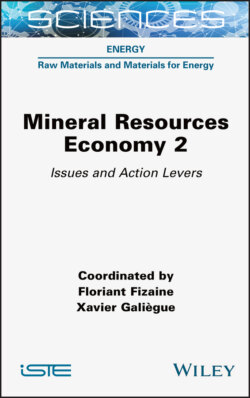Читать книгу Mineral Resource Economy 2 - Группа авторов - Страница 7
I.1. The stakes: between legal rules, interdependence of nations and interests of local populations
ОглавлениеFirst of all, it goes without saying that the perpetuation of a growth model based on the continuous growth of raw material needs, to which will most probably be added those (perhaps one-off) of the energy transition, places resource-importing countries in a difficult situation. In this context, the multiplication of criticality studies of raw materials testifies to the growing concern of countries and companies that rely heavily on international flows of natural resources. The contribution of Emmanuel Hache and his co-authors (Chapter 1) clearly shows that these criticality studies nonetheless bias reality by displacing consumers at the mercy of all-powerful producer countries. Yet this interdependence is often mutual, and it is therefore necessary to weigh the supply risk by also analyzing the diversity of exports from producer countries. Moreover, in this giant chess game, the availability of national resources (even untouched ones), the threat of the substitution of an alternative resource or a supply route from a cooperative country can certainly reduce the risk of supply disruption even in the case of a high level of dependence. Nevertheless, the reduction of the need for resources (sobriety and material efficiency) always seems less uncertain than securing access to primary resources.
Moreover, access to mineral resources is fundamentally shaped by legal rules and regimes, as demonstrated by the contribution of Stéphanie Reich-de Vigan (Chapter 2). Important differences remain between the legal regimes in the area of territorial and extraterritorial mineral resource ownership, which are not neutral with regard to incentives to extract or protect the environment. If our socio-cultural models focus on the economic part of sustainable development, it is likely that legal regimes for resource extraction will be brought into coherence to reflect this overarching objective. This will probably be to the detriment of the environment and by accentuating anthropic pressure on the last natural areas that have been relatively spared until now (Antarctica, the seabed in international waters).
There are, however, other options highlighted by the example of New Zealand. Indeed, New Zealand is one of the emblematic countries that have exploited the extension of the border, i.e. developed by relying on an adjacent geographic region exceptionally endowed with natural resources and characterized by a low human:earth ratio balance (Barbier 2011). However, when the United States continues to legally open other borders across the board – such as the treaty legalizing the private exploitation of asteroids – New Zealand opted for a different choice in 2017. Indeed, under pressure from the Iwi (Maori), who give the Whanganui River a different cultural representation from the British, the latter has been given a legal personality, allowing it to defend its interests in legal proceedings with the help of two lawyers. One can legitimately think that this will undoubtedly modify the future extractive trajectories near the river. This is again a good example of the importance of feedback from the human sciences on the opposing pressure by humans on the biosphere and the geosphere.
Within this framework, the study of the occupation of space, settlements and territories occupied by mining activity can provide adequate information on the parameters likely to modify these trajectories. This is what Michel Deshaies is trying to do in his contribution (Chapter 3). By these means, he confirms the absence of determinism on the trajectory of this anthropogenic pressure. He also notes the growing difficulties in perpetuating the current extraction model in the face of local populations increasingly hostile to mining projects. Here again, we note that conflicts related to mining projects are essentially present in North, South and Central America, even though a significant share of extraction is also located in Africa and other OECD countries. This is evidence that social organization, institutions and culture play a significant role in maintaining or inhibiting the widespread extraction of mineral resources.
